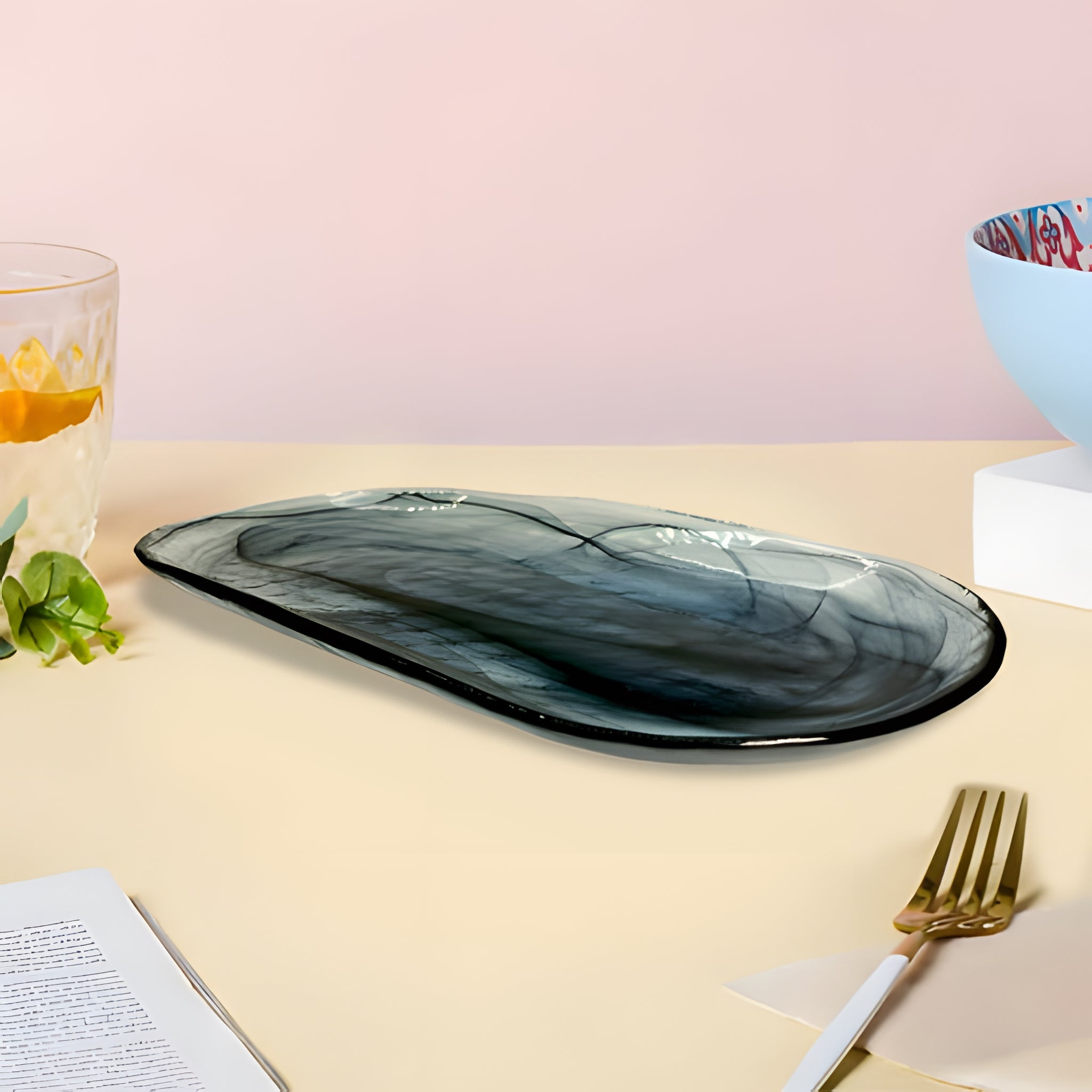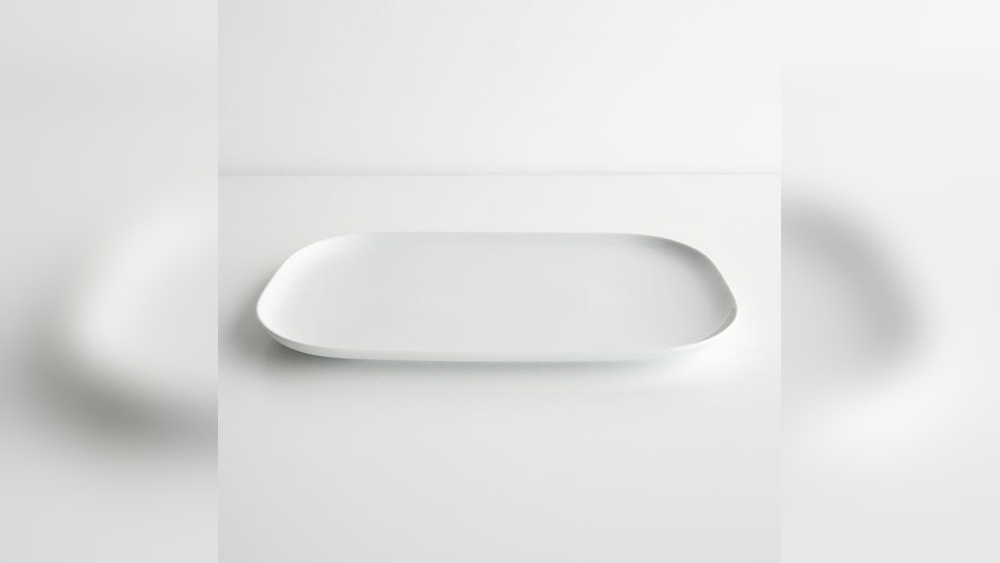Have you ever wondered why most platters come in oval or rectangular shapes rather than just round or square? The answer goes beyond mere aesthetics.
When you choose a platter, its shape affects how your food looks, how much you can serve, and even how easy it is to handle. Whether you’re hosting a casual get-together or a formal dinner, understanding why platters are designed this way can help you serve your dishes with style and ease.
Keep reading to discover the clever reasons behind these popular shapes—and how they can transform your dining experience.

Credit: lemontreehome.in
Oval Platters
Oval platters bring a unique elegance to any dining table. Their curved shape offers a smooth flow that complements many food arrangements. These platters are popular in homes and restaurants alike. The design blends functionality with a pleasing look.
Design Features
Oval platters have rounded edges and an elongated shape. This design allows easy access to food from all sides. They usually have a shallow depth to hold a variety of dishes. The smooth, continuous curve helps prevent spills. Materials often include ceramic, glass, or metal for durability and style.
Common Uses
Oval platters often serve main dishes like roasts or whole fish. They work well for arranging sliced meats or cheese. Many use them to display appetizers or finger foods. Their shape fits well on buffet tables or family-style meals. Oval platters also suit festive or casual dining settings.
Advantages In Presentation
The curved shape of oval platters enhances food presentation. It creates a natural frame around the dishes, drawing attention. The elongated design helps arrange food in neat rows or groups. Oval platters fit well on narrow tables or crowded surfaces. They add a graceful touch without overwhelming the table space.
Rectangular Platters
Rectangular platters offer a practical and stylish way to serve food. Their straight edges and elongated shape make them a popular choice in many kitchens and dining settings. These platters help present food neatly and clearly, enhancing the dining experience.
Their design suits various types of dishes, from appetizers to main courses. This shape fits well on tables and trays, using space efficiently. Rectangular platters often balance function with elegance, making them versatile for casual or formal events.
Design Features
Rectangular platters have straight sides and right-angled corners. This shape allows for easy stacking and storage. Their flat surface offers a stable base for different foods. Many are made from materials like ceramic, glass, or metal. Handles or raised edges are common to prevent spills. The clean lines create a modern and organized look.
Common Uses
These platters often hold finger foods, sandwiches, and sliced meats. They work well for sushi, cheese, and fruit arrangements. Rectangular shapes fit nicely on buffet tables or narrow spaces. They also serve as trays for snacks or desserts. Their size suits both small and large gatherings. Caterers and restaurants frequently use them for efficient serving.
Advantages In Serving
Rectangular platters make it easy to arrange food in rows or sections. This helps guests choose items without crowding. The shape allows for better portion control and neat presentation. They fit well on rectangular tables and trays, saving space. Serving from a rectangular platter is convenient and quick. Their sturdy design supports heavy or multiple dishes safely.
Shape Impact On Food Display
The shape of a platter plays a key role in how food looks and fits on it. Oval and rectangular platters help make the food display neat and inviting. Their shapes influence space, arrangement, and the overall presentation.
Space Efficiency
Oval and rectangular platters use space wisely. Rectangular shapes fit well on tables and buffet lines. They allow more food to be placed side by side. Ovals offer smooth edges that save room. This helps serve more dishes without crowding.
Visual Appeal
Food looks attractive on oval and rectangular platters. The clean lines of rectangular platters create a modern, organized look. Oval platters add softness and elegance to the display. These shapes guide the eye along the food, making the spread more inviting.
Portion Arrangement
Both shapes help arrange portions neatly. Rectangular platters divide space into sections, perfect for different foods. Oval platters allow curved arrangements that highlight main dishes. They both keep food from mixing and make serving easy for guests.
Material Choices For Platters
Platters come in various materials, each offering unique benefits for serving food. The choice of material affects durability, style, and usability. Oval and rectangular platters often use specific materials to enhance their design and functionality. Understanding these options helps in picking the right platter for different occasions.
Metal
Metal platters are sturdy and long-lasting. They often have a sleek, modern look. Stainless steel is popular for its resistance to rust and easy cleaning. Silver platters add a classic, elegant touch. Metal platters handle hot foods well and are ideal for formal events. They are lightweight yet strong, making them easy to carry.
Ceramic
Ceramic platters offer a smooth surface and vibrant colors. They can be glazed to resist stains and scratches. Ceramic holds heat, keeping food warm longer. These platters are perfect for casual and formal settings. They often come in various shapes and patterns, adding charm to the table. Handle ceramic with care as it can chip or break.
Glass And Wood
Glass platters provide a clean, transparent look. They highlight the food’s colors and textures beautifully. Tempered glass is safer and more durable for everyday use. Wood platters bring warmth and a rustic feel to serving. They are lightweight and easy to handle. Wood requires proper care to avoid staining and cracking. Both materials suit different moods and dining styles.
Choosing Platters For Occasions
Choosing platters for occasions depends on the event type and the food served. The shape of platters affects presentation and ease of serving. Oval and rectangular platters suit different settings and dishes. Picking the right shape helps enhance the dining experience and matches the event style.
Formal Events
Rectangular platters offer a neat, structured look for formal meals. They fit well on long tables and create clean lines. Oval platters add elegance and soften the table’s appearance. Both shapes display food attractively for formal dinners or receptions. Serving appetizers or main courses looks refined on these platters.
Casual Gatherings
Oval platters work well for relaxed meals and family dinners. Their smooth curves give a friendly, warm feeling. Rectangular platters allow easy sharing and portion control. Both shapes hold a variety of foods like sandwiches, cheeses, or finger foods. Their size and shape help guests serve themselves comfortably.
Buffet And Family Style
Rectangular platters maximize space on buffet tables. They fit side by side, making it easy to offer many dishes. Oval platters help highlight special dishes with a unique shape. Both shapes keep food organized and accessible. Their design supports easy passing and sharing at family-style meals.

Credit: www.amazon.com
Combining Platters With Tableware
Combining platters with tableware creates a balanced and inviting dining experience. Platters in oval and rectangular shapes fit well with different plate styles and sizes. Their shape offers versatility for arranging food and table settings. Thoughtful combinations add visual appeal and improve functionality during meals.
Matching tableware elements helps maintain a cohesive look. Using accessories and placemats enhances the overall presentation. These details bring charm and elegance to any table arrangement. A well-combined setup encourages guests to enjoy the meal and environment.
Matching Plates And Platters
Choose plates that complement the shape of your platters. Oval platters pair nicely with round or oval plates. Rectangular platters work well with square or rectangular plates. Matching shapes creates harmony and a polished look. Color coordination also plays a key role in matching pieces. Subtle patterns or solid colors keep the focus on the food and table design.
Using Placemats And Accessories
Placemats add texture and frame your tableware beautifully. Use neutral or contrasting colors to highlight platters and plates. Accessories like napkin rings, cutlery, and glassware enhance the setting further. Keep accessories simple to avoid overpowering the main pieces. Small decorative items can add personality and warmth to the table.
Enhancing Table Setting
Arrange platters thoughtfully to create balance and flow. Place larger platters in the center for easy reach. Smaller plates and bowls can surround the main platters. Layering plates and platters adds depth and interest. Lighting and centerpiece choices also impact the overall look. Together, these elements create an inviting and stylish dining experience.
Maintenance And Care Tips
Proper maintenance keeps platters looking fresh and lasting longer. Caring for oval and rectangular platters is simple with the right steps. Cleanliness and storage play a key role in preserving their shape and finish. Follow these tips to protect your platters from damage and wear.
Cleaning Methods
Use mild soap and warm water for cleaning platters. Avoid abrasive scrubbers that can scratch the surface. For stubborn stains, soak the platter briefly before wiping. Dry with a soft cloth to prevent water marks. Never use harsh chemicals or bleach on delicate materials.
Storage Solutions
Store platters in a dry, cool place to avoid warping. Keep them upright or flat with padding between each piece. This prevents scratches and chipping. Use shelf liners or cloth to cushion delicate surfaces. Avoid stacking too many platters to reduce pressure and breakage risk.
Handling Delicate Materials
Handle ceramic or glass platters with care to avoid cracks. Support the base firmly when lifting or carrying. Avoid sudden temperature changes that can cause damage. Use both hands to carry large oval or rectangular platters. Store fragile platters separately from heavier items.

Credit: www.amazon.com
Frequently Asked Questions
What Is An Oval Tray Used For?
An oval tray stores long items like pens, glasses, or stationery. It also serves as a key holder, accessory tray, or cash tray.
What Shape Is A Platter?
A platter is a large serving dish that can be oval, round, rectangular, square, or octagonal in shape.
What Is An Oval Platter?
An oval platter is a large, shallow dish shaped like an oval. It serves food stylishly and fits various table settings.
What Are Oval Plates Used For?
Oval plates serve well for presenting main dishes, sandwiches, and breakfast foods. Their shape fits table settings and enhances food display.
Conclusion
Oval and rectangular platters suit different serving needs well. Oval shapes offer smooth curves that fit varied foods nicely. Rectangular platters provide straight edges, making arrangement easier. Both shapes maximize space on tables and trays. Their designs balance style and function for any meal.
Choosing the right shape helps present food attractively. Platters in these shapes remain popular for practical reasons. They support better serving and sharing during gatherings. Simple yet effective design meets everyday dining demands.

